The Best All-In-One Audio Mixer Interface for Your DAW (or Standalone Recording) [Updated 2023]
Mixer, Interface or Standalone Recorder: Why Not All Three?
If you’re a home recording musician or any kind of audio engineer, there’s that one question that you’ve undoubtedly faced at the beginning of your recording journey. “What tool am I going to actually use to allow me to record music?”
At the end of the day, we are all capturing sound of various forms onto some sort of medium where it can be listened to by discerning ears. And what exactly that medium is has largely been some sort of digital audio workstation for the large majority of home recordists or professional engineers, through some sort of audio interface that is acting as an A-D converter.
Years ago, there used to be a handful of standalone portable hard-disk recorders, but cheap hard drives and the lower prices of laptops have made those all but obsolete. If you wanted to record digital audio, some form of audio interface and computer needed to be involved.
But things have gotten a bit more interesting with this equation in the past few years, as a few companies have ventured to remove the computer from the equation all together and allow users the ability to record digital audio straight to an SD card that can then be used to transfer these files to a DAW at a later time.
It sounds too good to be true—and it almost is in a way, because there are a very small number of products that actually do this very thing: record to SD card with some flexibility. (Spoiler alert: one of the products mentioned below doesn’t actually record to SD card, but we’re including it as an honorable mention).
Most of these products are a combination analog mixer with some form of audio interface attached, as well as an SD recorder and playback device. Some of these work purely as audio interfaces as well. Which of the following mixers you choose is probably going to come down to your own preferences and individual needs.
Is portability going to be most important to you? Reducing clutter in your studio? Feature set? Or mainly just ease of use? Each of the following mixers is going to excel in one of these areas, as the truth is they are all incredibly capable recording devices and a step up in sound quality from the type of hard disk recorders that were prominent 20 years ago. Let’s dive in!
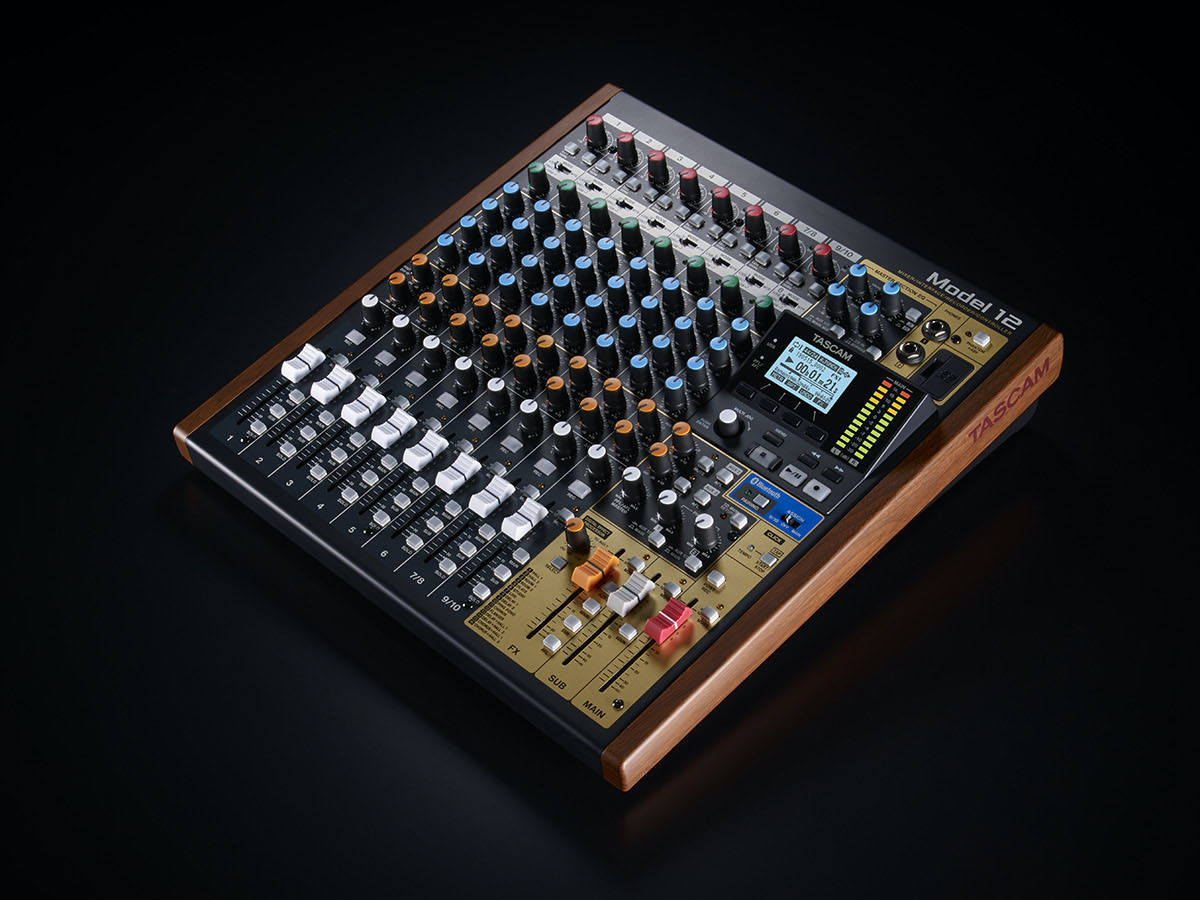
Tascam Model 12
Buy it new on Sweetwater, B&H, Thomann, or Amazon. Look for deals on Reverb.
Tascam Model 12
Tascam clearly knows something about the home recording market, given their lineage of Portastudios that are now considered classic studio tools, not only for their sonic quality but also their hands-on approach to manipulating tape. When the Model 12 was announced back in 2020, many claimed that this was the product they had been waiting on Tascam to make for years—a fully featured analog mixer, attached to an SD card recorder, with the ability to play back from the card or record live on a per-track basis.
Several different versions of this mixer are available, including the Model 12, Model 16, and the Model 24, each with the number of channels that you’d expect based on the name. It’s possible to record 12 (10 tracks plus stereo master) straight to SD card at 24-bit resolution. The Model 12 can also function as a 12-in, 10-out audio interface, so if you want to work with your favorite DAW and bypass the SD recording altogether, you can. This hybrid workflow gives the Model 12 legs and many have already made the Model 12 the centerpiece of their home recording workflow.
Pros
Each channel features a long 60 mm channel fader, three-band EQ (with a sweepable mid), two aux sends, and a built in, one-knob compressor, which is quite usable. Further sound shaping can be done with the three-band master EQ, another nice touch on the Model 12. The tilted up screen make the ergonomics of using the Model 12 a bit easier than other models in this list. Furthermore, all of the input and outputs are on the back of the unit, leaving the top less cluttered and easier to incorporate into tight spaces.
Overall, the ability to work both as audio interface and standalone mixer/recorder is ace and makes this the product to beat in this category. The built-in effects are nice to have as well, even if they aren’t of the highest quality. The fact that each track is a button-click away from either recording or playing back already-recorded audio leads to a pretty speedy workflow.
Cons
In terms of cons for the Model 12, some might not dig the retro look and vibe, as the faux wood sides do make it look a bit dated. Furthermore, the screen is a bit low-resolution by today’s standards. It’s also slightly pricey compared to other entries in this list, and if it matters to you, the digital resolution on the recording side only goes up to 24 bit/48khz. Lastly, it’s a bit heavy for how big it is, so it’s not that mobile.
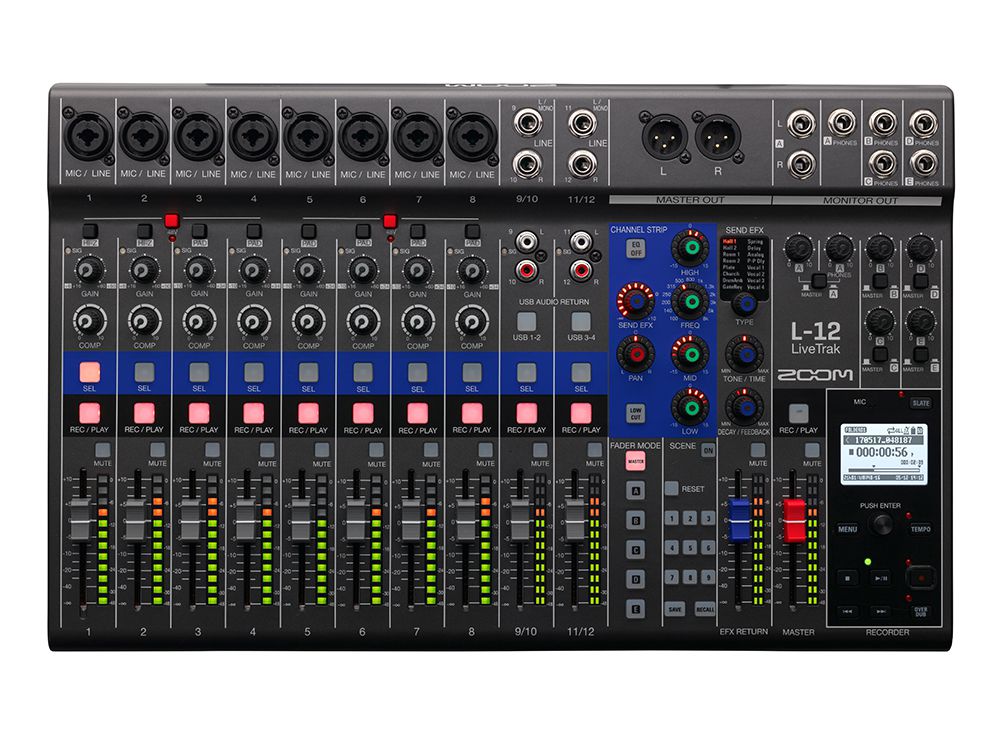
Zoom Livetrak L-12
Buy it new on Sweetwater, B&H, Thomann, or Amazon. Look for deals on Reverb.
Zoom Livetrak L-12
Zoom is also no stranger to the home recorder market, as their handheld recorders have been mainstays in studios and bedrooms across the world alike. The Livetrak L-12 (and its little sibling, the L8) are fully featured recording devices and interfaces that record straight to SD card and can also act as audio interfaces. The L-12 features 12 tracks (hence its name)—8 mono tracks and two pairs of stereo tracks. There are 16 effects to choose from, as well as built-in compressors per channel.
The L-12 takes a bit of a different approach to the Model 12 in that it uses a ‘channel-strip’ workflow. This essentially means you select a track, and then use the three-band EQ, effect send, and pan knobs to make changes on a per-track basis. It’s a bit more ‘one-at-a-time’ than the Model 12 but it’s as fully featured. Notably, there are five headphone outs, each with a configurable mix.
Pros
This channel strip-like workflow means that the interface is a bit less cluttered and the entire unit can be smaller as a result. This makes it easier to see the L-12 as a portable, easy to bring recorder as compared to some of the other entries here. As mentioned, an unprecedented five pairs of headphone outputs means you can really turn off your monitors and do some quality recording with no bleed. The fact that each headphone output can have its own custom mix has shown that Zoom have really thought about how this unit is going to be used. The one-knob compression available per channel, combined with the wide variety of built-in effects make the L-12 a very usable recording device.
There’s also a card reader mode that allows you to directly transfer files to the computer, as well as a two second recording buffer in case you didn’t quite hit record fast enough. All of these thoughtful features, coupled with the fact that the L-12 is fairly compact and lightweight and it makes a compelling case for your next studio tool.
Cons
What are some downsides to the L-12? Well, even though it can also be seen as a pro, the channel strip-like workflow means it’s a bit less hands on than competitors like the Tascam. Also, the audio interface connectivity is more limited—14 simultaneous inputs but only four outputs, accessed via select buttons on tracks 9/10 and 11/12.
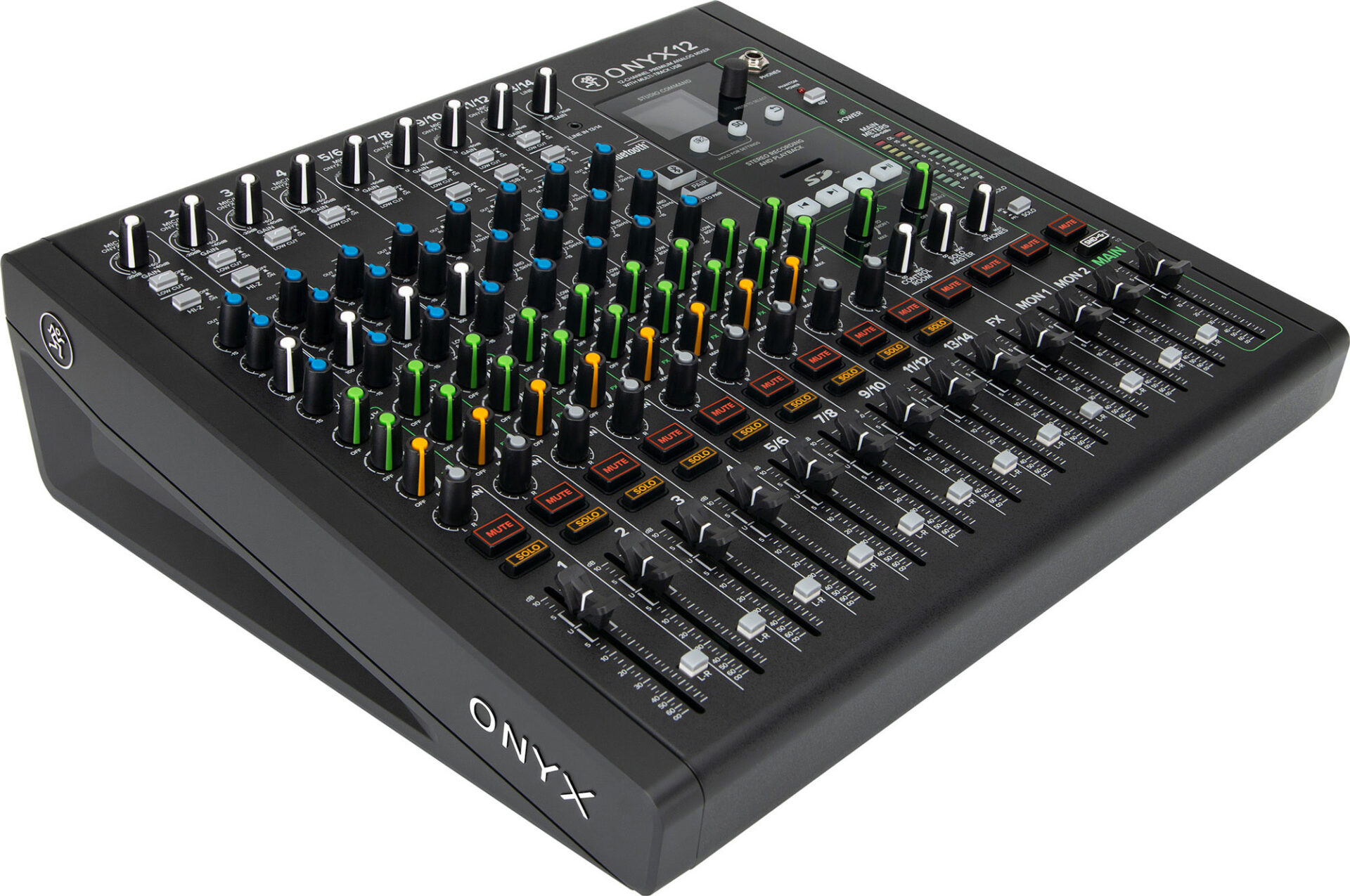
Mackie Onyx12
Buy it new on Sweetwater, B&H, Thomann, or Amazon. Look for deals on Reverb.
Mackie Onyx12
Mackie’s previous generation of Onyx mixers relied on the Firewire protocol but they were one of the first series of products to combine the mixer/audio interface into a single product. As the Firewire protocol became less popular and less used in studios, those boards slowly faded off, but Mackie revised them last year with the announcement of the Onyx8, Onyx12, Onyx16, and Onyx24, giving home recordists plenty of size options. This new line of Onyx mixers also feature the ability to record directly to SD card as well as act as audio interfaces to your host DAW. However, unlike the Tascam, this is only a stereo recording of the main output, not each individual channel. The Onyx12 features, as you might have guessed, 12 channels with 24bit/96 khz recording capability. There is a three-band “Perkins” EQ with switchable bypass and Onyx Preamp with 60db of gain on each channel 1-12. There’s also an additional channel, labeled 13/14, with the ability to connect to a Bluetooth device, or connect directly via an ⅛” jack on the top of the mixer.
Pros
Mackie’s updated look for the Onyx series is professional to a T—clean matte black, with big, easy to grab mute and solo buttons, sturdy faders, and sturdy knobs. This inspires confidence in using the Onyx right away. All inputs and outputs on the back of the mixer make the top less cluttered, just like the Tascam. There are inserts on the first four channels, plus separate outputs for control room and monitor sends, meaning there are plenty of routing options. The main outs come on both balanced XLR jacks and ¼” outputs. Furthermore, the various size options means it can appeal to a wider variety of musicians and producers. Mackie certainly has brand loyalty when it comes to mixers, and while this new Onyx range hasn’t quite taken off yet, I could see it growing in popularity.
Cons
In terms of negatives for the Onyx12, there are no individual meters per track—just a master meter and clipping level indicators on each channel. As mentioned earlier, recording to SD card is just the main stereo output. On a similar note, it’s only possible to get the main stereo return from the computer, unlike some of its competitors. The Onyx12 is also slightly on the bigger and heavier side, so you’re probably not going to want to be moving it back and forth from your studio to your practice space, despite what the literature will have you believe.
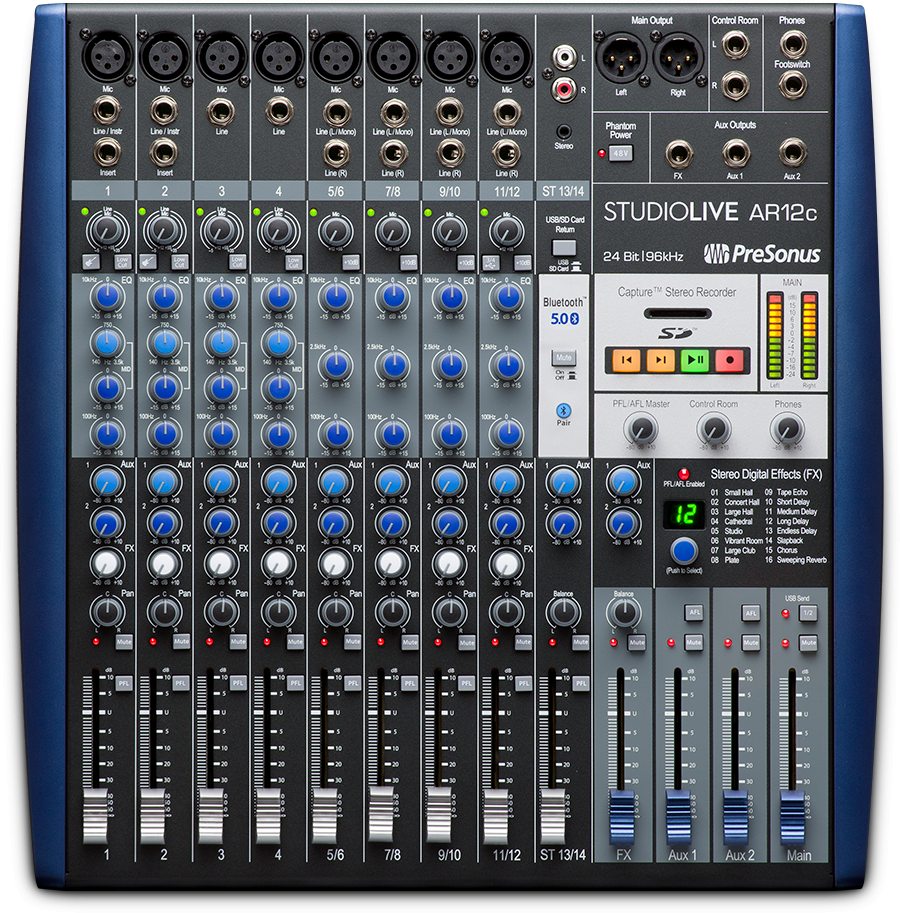
PreSonus AR12c
Buy it new on Sweetwater, B&H, Thomann, or Amazon. Look for deals on Reverb.
PreSonus AR12c
The Presonus AR12c, similar to the AR8c, I reviewed back in 2020 in a more extensive report, is another mixer in the SD recorder/audio interface category. The 12c features 12 tracks and a built-in 24 bit/96khz SD recorder, though it’s worth noting that unlike the Tascam (and like the Onyx12 I just mentioned), this only records the stereo output of the mixer and not each individual track. All of the input and output jacks are on the top of the mixer as opposed to the rear, and the AR12c features a bright and bold design that is going to appeal to some and possibly turn others off.
Pros
In terms of pros for the AR12c, it’s very nice that the FX return and both aux 1 and 2 get their own full faders. The so-called “Super Channel” combines four stereo inputs at once, so one channel can be used for a variety of playback devices, meaning you don’t have to sacrifice valuable channels just to have mp3 playback-useful for venues and bars. This channel also features bluetooth connectivity as well. Looking at the signal path of each channel, it’s clear to see that Presonus have put a lot of thought into the design. For example, it’s also incredibly handy that each channel is equipped with a high pass filter. As mentioned, the AR12c works as a 14-input/4-output audio interface at 24bit/96khz as well, so you are covered in case you do want to go the DAW route.
Cons
Unfortunately the SD card only records capture of the Stereo output, unlike the Tascam which records each individual track to the SD card. This definitely makes the PreSonus less useful. The top loaded design means cable clutter could be a possibility, and not everyone is going to love the very blue-centric design approach. I also felt that the knobs feel a bit cheaper and flimsier than some of the other entries in this list. It’s also worth mentioning that phantom power is global only, the effects are not tweakable and sound a bit cheap in general, and only tracks 1 and 2 feature inserts.
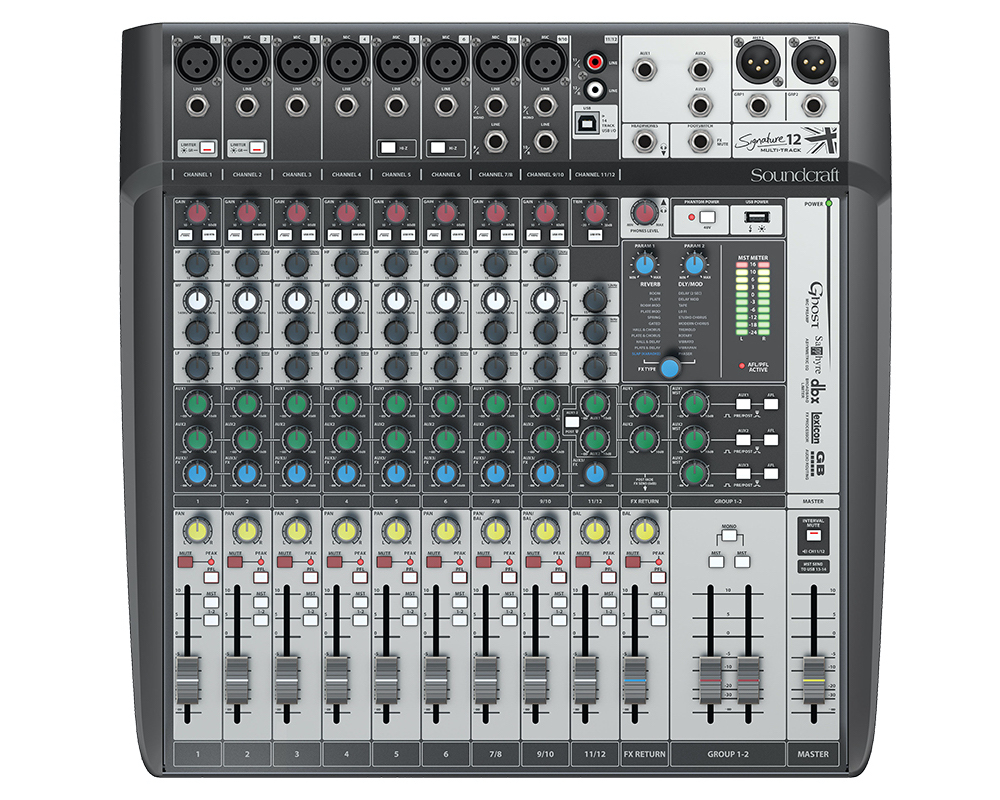
Soundcraft Signature 12 MTK
Buy it new on Sweetwater, B&H, Thomann, or Amazon. Look for deals on Reverb.
Soundcraft Signature 12 MTK
Last but not least, we have the Soundcraft 12 MTK, another digital/analog mixer hybrid from a brand well-respected for its more premium mixer offerings. The 12 MTK is the only offering in this list that doesn’t have the ability to record to SD card, so if the need to be able to record truly computer-less is high on your list of priorities, you can cross off the MTK series, which comes in both 12-channel and 24-channel versions.
However, what you do get with the 12 MTK is a very flexible 14-in/12-out audio interface, as each track features a button to switch from live input (whatever’s plugged into that channel) or the corresponding digital track from your computer. This makes it very easy to combine recorded and live inputs at once. The 12 MTK also features the highly respected Ghost preamps and a built-in effect panel from Lexicon, so there’s a lot to like even without SD recording.
Pros
The 12 MTK feels like a more premium offering at a less than premium price, given the brand’s heritage. Even though it doesn’t have SD card recording, it makes up for it by working as a fully featured audio interface with 10 return outputs, as each track can be a digital return channel. The built-in effects actually have two editable parameters (though not saveable). Furthermore, the group 1, 2 bus makes it easy to control the levels of several instruments at once. Soundcraft have given users a high pass filter and sweepable mid-range frequency on channels 1-10, and built in one-button limiter on channels 1 and 2. The long 60 mm faders feel nice for this price range (and in general). The 12 MTK feels fairly affordable given the high I/O count.
Cons
As mentioned, there is no SD card recording on the 12 MTK or its larger sibling, so if you absolutely need to be able to record without a laptop, cross these off your list. On the mixer side of things, there are no dedicated inputs for aux returns, so you must sacrifice an input channel to hear these aux buses. There are a few small ergonomic issues as well. For example, the mute buttons are fairly small and hard to get to quickly since they are surrounded by other buttons that you don’t want to press accidentally. Like a few entries in this list, it’s a top loaded mixer so cable clutter could be real. Lastly, it feels a bit flimsier than you’d expect given the Soundcraft name. The knobs look nice but they feel a bit flimsy to the touch. Additionally, the design and overall look is a bit dated compared to some of the other options.
Leo Maymind is a producer, DJ, and writer living in Los Angeles, CA. He is obsessed with sound, and you can reach him at lmaymind@gmail.com.
Please note: When you buy products through links on this page, we may earn an affiliate commission.








[…] Source link […]